If you’re an art lover planning a trip to Italy, be sure to include the town of Ravenna on your itinerary. Ravenna is home to some of the world’s most important Byzantine mosaics, making it a glittering jewel box of 5th and 6th century art.
The city boasts a rich history as it was once the epicenter of the Western World when the Byzantine Empire made Ravenna its capital.
The Byzantine rulers adorned the churches of Ravenna with stunning mosaics. The poet Dante described them as “the sweet color of Oriental sapphires.”
This artistic legacy rivals, or even surpasses, that of Venice and Istanbul. Ravenna has a whopping 8 UNESCO sites to explore and I’ve seen them all.
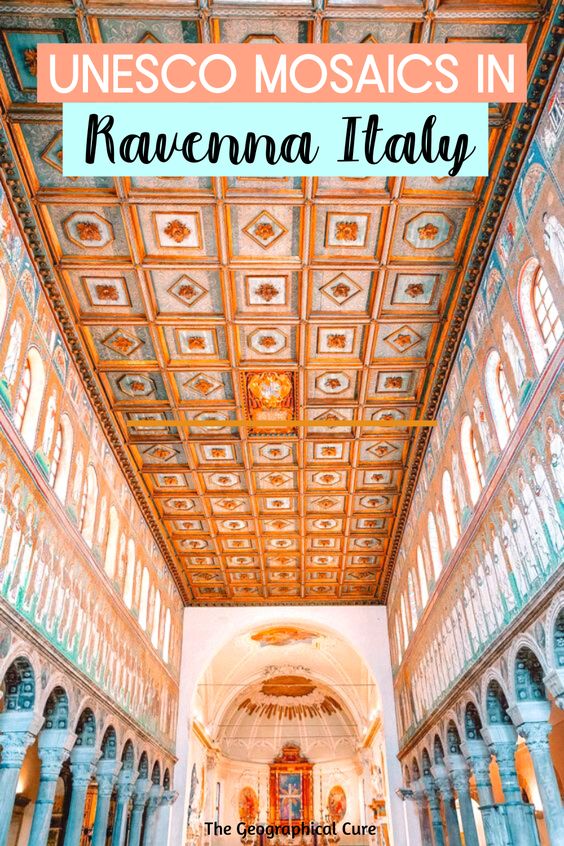
In this Ravenna travel guide, I give you a short history of Ravenna, describe the mosaic attractions, and tell you exactly where to find them.
This small quiet city in the Emilia-Romagna region of northeast Italy isn’t as well known as Italy’s other beautiful towns. But Ravenna is a lovely off the beaten path hidden gem in Italy, a nice stop on the way from Venice to Florence.
Here’s everything you need to know about visiting the remarkable Ravenna mosaics!
A Short History of Ravenna
But first, how did Ravenna come to be such an important repository of Byzantine art? Let’s take a quick look at Ravenna’s history.
In 410, Rome was sacked by Visigoths. In 476, the last western emperor (Romulus August) was deposed, marking the official fall of Rome.
Although the Roman Empire fell in the west, it continued to exist in the east.
In 330, Emperor Constantine had made Constantinople (now called Istanbul) his eastern capital. Modern historians simply renamed the Eastern Roman Empire the “Byzantine Empire.”
After Constantine’s death, the empire began to decline. In 383, Theodosius I ascended the throne when the Roman Empire was in great danger. Theodosius was a successful administrator and secured his borders.
Theodosius decided to recapture the former western Roman territories.
In 401, to further this goal, his son Honorius established a new western capital in Ravenna. During this time, the Mausoleum of Galla Placidia and the Baptistery of Neon were built.
Why does Theodosius choose Ravenna, a backwater coastal town? Mostly because its swampy marshland was a hard-to-attack spot near the Adriatic. If Theodosius had to beat a hasty escape, he could.
Honorius was a weak emperor though. In 493, he was defeated and Ravenna became the capital of the Ostrogothic Kingdom of Italy. Under Theodoric the Great’s reign, the Church of Sant’Apollinaire in Classe and Theodoric’s Mausoleum were constructed.
In 540, the greatest Byzantine emperor, Justinian, came to power and took back Ravenna from the goths. Like Theodosius, he wanted to take back western Italian lands as well.
Justinian’s imperial troops conquered the surrounding area and then took Rome, forming an area known as the Byzantine Corridor. It was a land/sea route that allowed Constantinople to communicate with Rome. The pope became the representative of the Byzantine Empire in Rome.
Under Justinian, Ravenna became the sister city of Constantinople, or the “Constantinople of the West.” As Hagia Sofia was being built in Constantinople, the beautiful Basilica of San Vitale was being built in Ravenna. In it, you see an iconic image of Justinian himself.
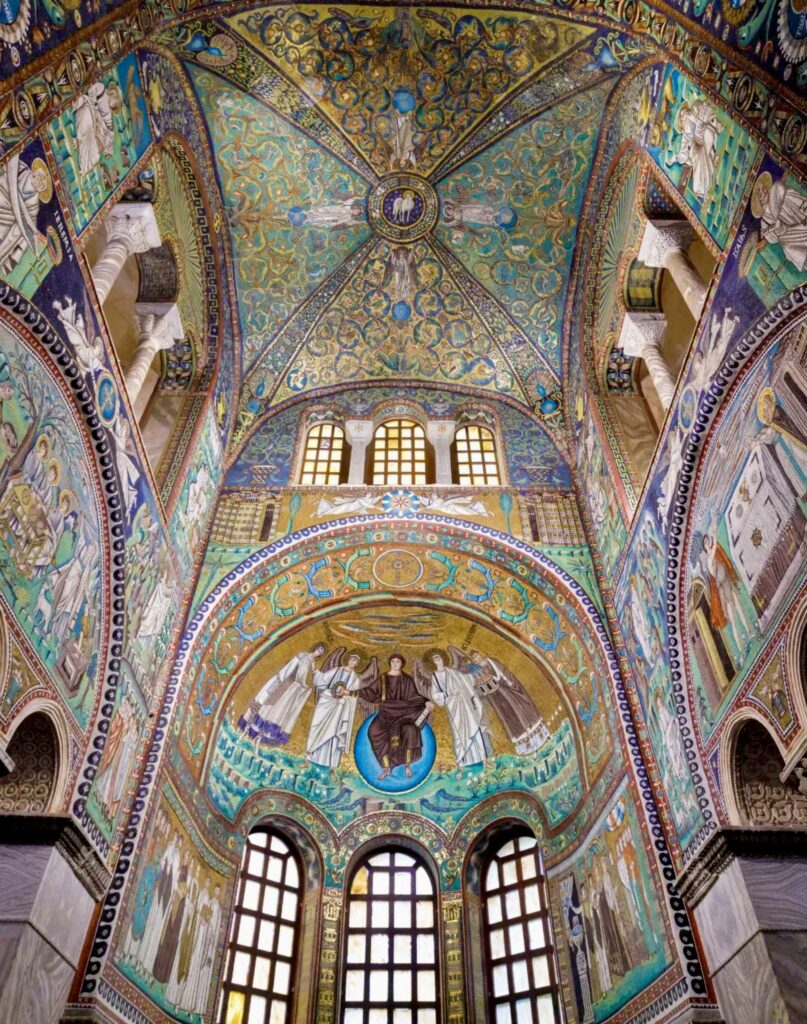
In 750 or so, Ravenna’s golden heyday ended when the Lombards booted the Byzantines out. Shortly after that, Ravenna was conquered by the Franks and relegated to the role of provincial town. But it continued to grow and build, with Gothic and Baroque influences found all over the city.
Through the centuries, many famous artists and writers arrived to admire Ravenna’s sparkling mosaics — George Byron, Gustav Klimt, Oscar Wilde, and Herman Hesse. Perhaps the most famous devotee was Dante Alighieri, the author of the Divine Comedy and father of the Italian language.
After being exiled from Florence for his political beliefs, Dante spent his last three years in Ravenna, dying there in 1321.
You can visit Dante’s simple marble tomb to pay your respects. It’s located in a small neoclassical temple, right next to the Basilica di San Francesco in the historic center.
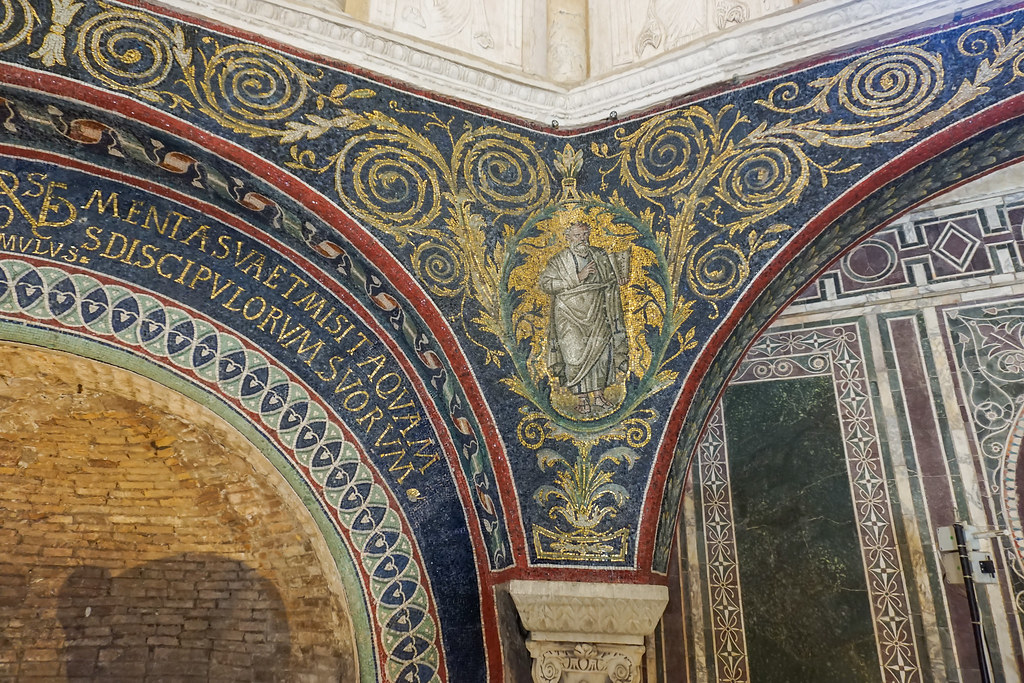
Tours Of Ravenna
Because of the historic nature of the monuments and mosaics in Ravenna, you may want to take a guided tour.
And there are quite a few options:
- a 5 hour guided tour with tickets
- a 3 hour guided tour with tickets
- a 3 hour mosaics + food tasting tour
- a guided small group tour
- a guided tour that leaves from Bologna
Ravenna: Early Christian and Byzantine Mosaics
Ravenna is overflowing with religious buildings decorated with in situ Early Christian Byzantine mosaics. There are 8 UNESCO World Heritage sites. The world’s two most famous mosaics — of Emperor Justinian and Empress Theodora — are here.
What you see in Ravenna is the transformation from the Roman world to the early Byzantine world. Byzantine art moved away from classical ideals and naturalism. It no longer made sense since the Greco-Roman world no longer existed.
Byzantine artists rejected the faithful reproduction of reality and adopted a flatter and more abstract style. The two dimensional art sought to depict what we couldn’t see, an intangible and ethereal world. No medium better demonstrates the glory and mystery of Byzantine culture.
Let’s tour Ravenna and visit its must see sites for viewing mosaic art. Prepare to be ravished by a golden glow.
Guide To The Mosaics Of Ravenna
Here’s where to find the glittering mosaics of Ravenna, spread out over 8 sites.
1. Basilica of San Vitale
Finished in 547 and almost 1500 years old, the Basilica of San Vitale is Ravenna’s masterpiece. It boasts dazzling Byzantine mosaics in the presbytery and choir, meant to evoke a heavenly realm.
In the apse above the altar, there’s a mosaic depicting Christ the Redeemer. He’s sitting on an orb representing the universe. Below him flow the four rivers of paradise.
On either side is an angel. Jesus hands a crown to San Vitale and a bishop holds a model of the church.
Just below is Ravenna’s pièce de résistance — two famous panels dedicated to the Emperor Justinian and his wife Theodora. They show the pair making offerings to Jesus against a field of gold.
They are both resplendent in fine capes and jewels, proving to the world that they’re back in charge. In reality, the mosaic is a piece of political propaganda.
Though the pair were both from lowly origins, Justinian and Theodora wear halos, testifying to their role in the divine. Justinian conflates himself with Christ and Theodora gives off mother Mary vibes.
The message is clear: the peace and prosperity of the Byzantine Empire is brought to you by both the emperor and God.
In her mosaic, Theodora is in regal purple, wearing incredibly elaborate jewelry, including a head dress. She’s bedecked in pearls (a sign of purity), and carries a chalice with big fat gems. But Theodora wasn’t exactly “pure,” though she was clever.
She started life as the beautiful daughter of a prostitute, with a speciality in showgirl dancing. Then, she became a high paid courtesan.
A wily social climber, she caught the eye of Justinian. He was so besotted that he changed a law forbidding emperors to marry actresses and made Theodora the empress of his lavish court.
Despite her humble origins, Theodora became one of the world’s most formidable and ruthless women. Theodora was a real partner to Justinian and held power in her own right.
She dabbled in social justice and enacted laws helping women and the downtrodden. But she also ordered the slaughter of 30,000 insurgents in 532.
The other San Vitale mosaics illustrate scenes from the Old Testament. They depict images of the 12 apostles and 4 evangelists, with the Lamb of God overseeing everything from atop the vaulted ceiling.
He represents Jesus as the sacrificial lamb. A divine offering, in contrast with the earthly riches held by the imperial couple.
In 1903, Austrian artist Gustav Klimt famously visited San Vitale. He was inspired. Klimt’s visit marked the beginning of his Golden Phase, when he created his best known works, like The Kiss.
READ: Guide To the Klimt Trail in Vienna
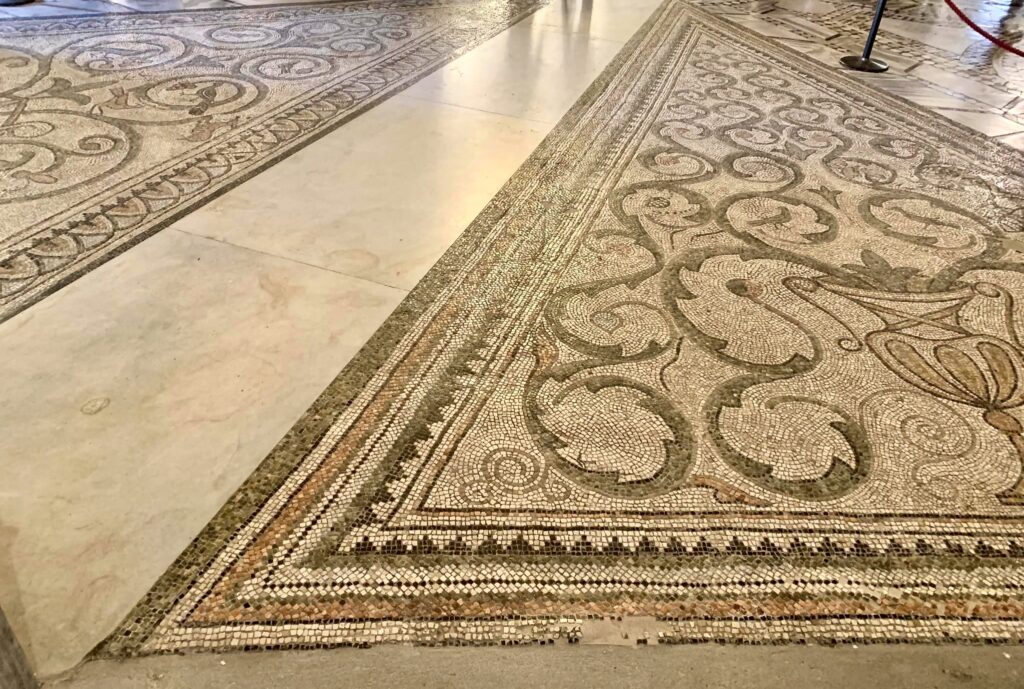
If you need even more information, Ravenna’s National Museum is in the monastery of San Vitale.
Exhibits include a stone tablet collection, Roman and Byzantine artifacts, and 14th century frescos. It’s not included on the combined ticket though and costs 6 euros (closed Mondays).
- Address: Via san Vitale 17
- Hours: March to Oct open daily from 9:00 am to 7:00 pm, from Nov to Feb open daily from 10:00 am to 5:00 pm
- Entry fee: cumulative ticket 9.50 euros
2. Mausoleum of Galla Placidia
Just across the courtyard from the basilica, you’ll come to the next site on your list, the Mausoleum of Galla Placidia. This tiny building was intended to be the resting place of an empress. It’s made of reused ancient Roman brick.
Galla Placidia was the wife, daughter, and granddaughter of Roman emperors. She was a powerful woman. She married the Emperor Constantius and acted as regent when her son became emperor.
The mausoleum contains three sarcophagi. But Galla died in Rome and was likely buried in the old (pre-Bramante/Bernini/Michelangelo) St. Peter’s Basilica.
The exterior of the mausoleum is austere. In stark contrast, the interior is breathtaking with Ravenna’s oldest (and some say best) mosaics.
UNESCO describes the site as “the earliest and best preserved of all mosaic monuments, and at the same time one of the most artistically perfect.”
On the ceiling, you’ll find the lovliest night sky ever produced. It’s a shallow dome depicting a sky of vivid peacock blue mosaics with white and golden stars.
A golden cross is placed at dome’s center, signaling the triumph of the cross over death. The symbols of the 4 evangelists hover around the cross.
Be sure to examine two other mosaics. One is the northern lunette representing a beardless Christ as the Good Shepherd, looking very Roman, just above the entrance. The idea is that Christ is the leader of his flock. It’s very decorative, with a beauty and luminosity.
The southern lunette shows the martyrdom of Saint Lawrence. The lunettes also have mosaics of deer drinking from a pond, signifying holy water as a source of life.
- Address: Via Fiandrini Benedetto
- Hours: March to Oct open daily from 9:00 am to 7:00 pm, from Nov to Feb open daily from 10:00 am to 5:00 pm
- Entry fee: cumulative ticket 9.50 euros
- Pro tip: There’s theoretically a time limit (5 minutes) to visit this site because it’s so tiny. On a quiet day, you can go in for another 5 minutes.
3. Basilica of Sant’Apollinare Nuovo
Built in the early 6th century by Theodoric the Great, this church was originally an Arian place of worship. The Arian cult was the official religion of the court of Emperor Theodoric.
As Goths, unlike early Christians, the Arians followed the doctrine of an Egyptian priest, Arius. He preached that Jesus was created by God and therefore subordinate in the holy trinity.
Following Justinian’s conquest of Ravenna, the basilica became a Catholic church.
It was re-dedicated to Saint Martin of Tours, a defender of the Christian doctrine against heretics. It received the name Sant’Apollinare Nuovo in the 9th century, when the body of Saint Apollinare, the first bishop of Ravenna, was moved there.
There’s a lot going on inside. On the walls of the central nave, you’ll see dazzling golden mosaics depicting the life of Jesus Christ.
On the left side, processions of martyrs and virgins approach Mary and baby Jesus. On the right side, 26 martyrs approach a bearded Jesus.
But the most interesting details in Sant’Apollinare Nuovo are the detached hand and forearm wrapped around the columns of the Palatium. It’s a trace of the original Arian decoration representing the emperor Theodoric and his entourage. Every other bit of Arian decoration was eradicated, to erase the church’s former dedication.
When you’ve had your fill of mosaics, you can linger in the peaceful cloister. Then admire the Leaning Tower of Ravenna en route to your next stop.
- Address: Via di Roma
- Hours: March to Oct open daily from 9:00 am to 7:00 pm, from Nov to Feb open daily from 10:00 am to 5:00 pm
- Entry fee: cumulative ticket 9.50 euros
4. Baptistery of Neon | Battistero Neoniano
Erected in 400, the Baptistery of Neon is Ravenna’s oldest monument. It may be the most well preserved baptistery in the world.
It’s a fine example of mosaics with a degree of Greco-Roman influence, in contrast with the Byzantine style found in Ravenna’s other mosaics.
Intensely colored blue, green and gold mosaics decorate the whole ceiling. As befitting the building’s purpose, the images depict John the Baptist baptizing Christ in the River Jordan. There’s an outer ring with mosaics of architectural scenes, characteristic of Roman mosaics.
- Address: Piazza del Duomo
- Hours: March to Oct open daily from 9:00 am to 7:00 pm, from Nov to Feb open daily from 10:00 am to 5:00 pm
- Entry fee: cumulative ticket 9.50 euros
5. Chapel of Sant’Andrea | Archbishop’s Chapel
Adjacent to the baptistery is the Ravenna’s cathedral museum, the Museo Arcivescovile. In a hidden chapel, you’ll find a mosaic with an extremely rare depiction of Jesus. He’s portrayed as a victorious warrior, his feet on a snake and lion.
The chapel is quite tiny, and not many people bother to see it. But it’s worth going inside to see the Jesus mosaic, the golden starry sky, and the animal mosaics. There are over 99 species of birds depicted.
- Address: Piazza del Duomo
- Hours: March to Oct open daily from 9:00 am to 7:00 pm, from Nov to Feb open daily from 10:00 am to 5:00 pm
- Entry fee: cumulative ticket 9.50 euros
6. Basilica of Sant’Apollinare in Classe
It’s time to leave Ravenna and travel 4 km to nearby Classe, the ancient seaport of Ravenna. The town boasts two masterpieces – the Basilica of Sant’Apollinare in Classe and the Classis Musuem.
The huge church reflects the town’s former importance. Until the 9th century, it housed the remains of its titular saint. They were taken back to Ravenna to to keep them safe them from marauding pirates.
The church boasts spectacular Byzantine mosaics covering its nave and apse. The apse is especially dazzling. The theme is the divine nature of Jesus. The tip top is golden and dominated by a bejeweled cross, with the effigy of God at its center.
The lower part of the apse represents a green, paradisiac valley with Sant’Apollinare at the center. He’s surrounded by plants, rocks, birds and 12 lambs, symbolizing the 12 apostles.
- Address: Via Romea Sud 224 Classe
- Getting there: You’ll have to take a bus or drive. Bus #4 leaves from Ravenna’s rail station and Piazza Caduti.
- Hours: Mon to Sat 8:30 am to 7:30 pm, Sun 1:00 pm to 7:00 pm
- Entry fee: 5 euros
7. Classis Museum
If you want to know more about Ravenna’s history, head over to the Classis Museum after visiting Sant’Apollinare in Classe.
This recently opened archaeological museum is worth a visit just for its striking architecture. It’s located in a beautiful building, which was a former sugar factory. At the entrance, there’s a striking blue mosaic decorating the entrance staircase, which evokes a wave.
In chronological order, the Classis Museum illustrates the history of Ravenna from its origin to the year 1000. Over 600 exhibits are on display, including examples of Roman mosaics. The collection comes to life with 3D reconstructions, scale models, and films.
- Address: Via Classense 29 Classe
- Hours: 10:00 am to 6:30 pm
- Entry fee: 5 euros, 1 euro for an audio guide
8. Arian Baptistery
The Arian Baptistery was built by Ostrogoth king Theodoric the Great at the end of the 5th century, after the Byzantine Empire consolidated its power. It was erected as a political move.
Two influential groups in the empire, the Goths (Arians) and the Latins (Christians), had different views of Christ. Only the Christians had a baptistery. To keep the peace, Theodoric built the Arian Baptistery to distinguish it from the Baptistery of Neon built a century earlier.
The Arian Baptistery is a small octagonal shaped building. The former stucco and decorations are long gone. But there are still beautiful mosaics in the cupola.
It’s a rare example of art from a lost religion. The concentric mosaics show (what else?) the procession of the 12 apostles and the baptism of Jesus.
An androgynous Jesus is shown as both an earthly and divine being. A dove hovers above his head, the symbol of the Holy Spirit.
- Address: Via Degli Ariani 1
- Hours: temporarily closed
- Entry fee: 2 euros
9. Mausoleum of Theodoric
While there are no mosaics in this mausoleum, it’s one of Ravenna’s UNESCO-listed sites. It’s located just outside the town center. But it’s easy to walk to.
Built in 520, the mausoleum is the tomb of Theodoric the Great. Its roof is made of a single Istrian stone slab weighing 230 tons. Historians don’t know how the stone was moved to Ravenna.
- Address: Via delle Industrie 14
- Hours: March to Nov from 8:300 am 7:00 pm. From Nov to Mar 8:30 am to 4:30 pm
- Entry fee: 4 euros
Practical Guide & Tips For Visiting The Mosaics of Ravenna
1. How to Get to Ravenna
By Plane – The closest airports to Ravenna are Bologna (1 hour) and Venice (2 hours).
By Train – If you’re traveling around Italy by train, head to Bologna and hop on a regional train. There are hourly departures. Travel time is 1 hour to 1:15. The train station is an easy walk to the town center. When you arrive, walk straight down Via Farini.
By Car – The closest motorway to Ravenna is the A14. Travel time by car from Bologna is about an hour.
Day Trip – With direct trains departing hourly, Ravenna makes a great day trip from Venice, Florence, Bologna, or Ferrara. You could also stop in Ravenna on your way from Venice or Padua to Florence.
2. How To Get Tickets For The Mosaics in Ravenn
You can see 5 of the best Ravenna mosaics (the first 5 listed above) with a combined ticket. You can purchase it online here. It’s valid for a single entry per site over 7 days.
Purchasing the combination ticket is the ONLY way to see these 5 sites. In summer months, there may be a 2 euro surcharge to see the Mausoleum of Galla Placidia.
The other 3 sites listed above require a specific admission ticket that you can purchase onsite.
You can also purchase tickets in person at the Ravenna Tourist Office in Piazza San Francesco. You can get a map or rent a bike for the day. Ravenna is very bike friendly and pedestrianized town.
3. Sample Itineraries For Ravenna: How To See the Sites Efficiently
If you are only in Ravenna for a half day trip, you won’t be able to see all these sites. You have to prioritize.
With only several hours, you should you focus your time and energy on these three sites: (1) the Galla Placidia Mausoleum; (2) the Basilica of Sant’Apollinare Nuovo; and (3) the Basilica of San Vitale.
If you want to see relics of the Arian religion, substitute the Arian Baptistery for the second site. If you’re really speedy, you may be able to squeeze in the other sites after seeing the big three.
If you have a full day and are walking from the train station, I suggest you see the monuments in the center of Ravenna in this order:
- (1) Arian Baptistery
- (2) Basilica of Sant’Apollinare Nuovo
- (2) Chapel of Sant’Andrea
- (4) Baptistery of Neon
- (5) Basilica of San Vitale
- (6) the Mausoleum of Gall Placidia
If you’re traveling by car and have ample time, consider stopping at the Classis Museum first. That will give you the perfect overview of Ravenna’s history before you see the mosaics in situ.
If you still have more time, drive or take the bus to the two sites in Classe.
4. Where and What To Eat in Ravenna
If you’re in Ravenna or the entire day, you’ll need lunch. Ravenna’s local speciality is the piadina. It’s a delicious toasted flatbread stuffed with sweet or savory filling and folded over.
In the Piazza del Popolo, you’ll fine one the best piadina spots — Profumo do Piadina Laboratorio del Palato. If you want to sit down, you can try the Antica Trattorio al Gallo or Trattoria la Rustica.
Ca’ de Ven is a restaurant in a historic building that dates back to the 18th century. It’s known for its traditional Romagnolo cuisine and cozy, rustic atmosphere.
5. Where To Stay In Ravenna
You have a few good hotel options in Ravenna. Check out:
- Hotel Palazzo Bezzi (luxury hotel with wellness center and Turkish bath
- Club de Luxe B&B (cozy bed and breakfast centrally located)
- Exclusive Aparthotel la Reunion (charming and hip suites)
- Grand Hotel Mattei (spacious rooms and well center 5 minutes from Ravenna)
I hope you’ve enjoyed my guide to the mosaics of Ravenna. You may enjoy these other guides to amazing Italian art.
- Guide To the Best Art in Italy
- Must See Art in Tuscany
- How To See Michelangelo’s David in Florence
- Guide to the Uffizi Gallery
- Guide to the Piazza della Signoria
- Guide to Florence’s Palazzo Vecchio Museum
- Best Museums in Rome
- Best Museums in Florence
- Guide to Rome’s Borghese Gallery
- Masterpieces at the Vatican
If you want to see Ravenna’s beautiful mosaics, pin it for later.

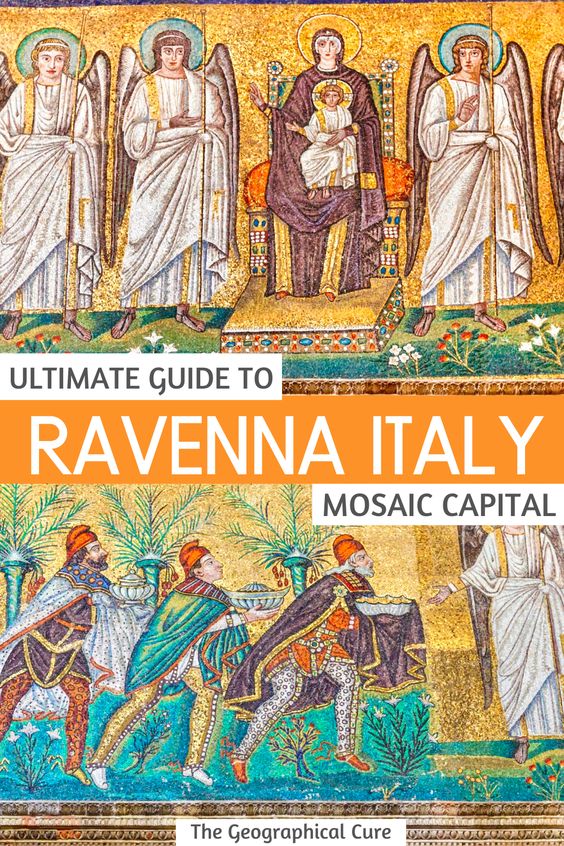
Great website! Thanks for sharing!
Thank you so much!
Thank you very much for this excellent website. Very informative and well done. I visited Ravenna over 40 years ago but now I am returning with my wife in September. Thanks again!
Thank you Eric. Have fun and enjoy the mosaics!
Very informative. Thank you!
You’re welcome Jan!